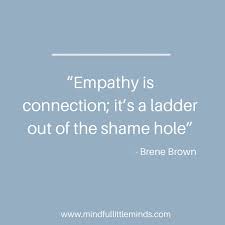
Once parents can acknowledge how shame shows up behind their children’s icky behaviors, they can begin using a new parenting approach that is therapeutic and individualized. It’s hard. It takes a ton of repetition. And time. And trust. And perseverance. Keep reading to learn real techniques to combat the negative effects of shame!
Empathy
Basically empathy here means you can step outside of yourself and see your child from a big perspective to truly understand how they feel. In this case, once you have identified how shame manifests itself, and each child is different, you can lean into empathy. Oxford dictionary defines empathy as the ability to understand and share the feelings of another. Sometimes just letting your child know you see them, you can feel what they feel; this can help improve the situation tremendously. Naming shame and the actions linked to it can be helpful so your child can start to be aware of this connection. Using empathy helps them to know that they are not alone.
Normalize Shame
Shame carries stigma. People tend to avoid the word. Then secrets and silence replace any opportunity to have an open and mending type of discourse. As stated previously, shame is one of the 7 core issues of adoption. So get talking about shame. Share your experience with this feeling. Narrate how it shows up for you. Continue talking about how you feel and how you manage shame. Explain to your child where their shame came from. Then slowly start to undo the tentacles of your child’s shame. Make shame a safe concept that requires examination to heal and grow.
Curiosity
A creative and non-threatening way to talk about your child’s shame with them is to to get curious. Instead of naming their defiance as shame, instead say I wonder what’s making you not want to do anything I ask. Continue to slowly and sensitively ask probing, non-judgemental questions about your child’s behaviors, never during the meltdowns, but later when you are processing with them. Give time for them to answer. Remain curious and wondering and let them guide the conversation. If they can link their tough behaviors to shame from their past, this is especially healing. This takes time but hang in there as this curiosity technique really works.
Shame=Parts
As you get used to talking about shame, make sure you consistently teach that shame is just one part of your child. There are so many other parts, some positive, some negative. Make sure to teach the idea that your child is not their behaviors. Explain that actions are just part of your child. Talk about all the parts of your child. Try to poke holes into your child’s idea that they are the mistake, everything is all their fault, they are bad vs. they made a mistake, that was not their fault, and their choice, was bad not them.
Model Regulation
No matter your child’s age, shame can show up, through loss of self-control. It can be a meltdown, self-harm, ranting and raving, and/or a complete shut-down. Just like narrating how you manage shame in your life, learn to model and narrate how you self-regulate. Breathe deeply 10 times and talk about it. Then ask your child to breathe with you, not in the middle of the meltdown, but later. Talk about it when you need a break to walk around the block to calm down. Next, invite your child with you for this calm down stroll. Keep talking about how you calm your body when you are upset. Model…model…model. No matter the age of your child, narrating, demonstrating, and sharing your ways of self-regulation is infectious.
 Connection Over Punishment
Connection Over Punishment
Punishment implies shame. Traditional parenting techniques, based on behaviorism, do not work for the child from a past marred with trauma. As it just makes your child feel worse, alienates you more from one another, and validates their belief that they are the problem. This connection-based parenting does not mean that your child does whatever they want to. This does not mean you are a loosy-goosy parent whose child sets the rules. Instead it means that you value your connection to your child over typical punishment techniques. Instead of time-out, you use time-in, where your child stays close to you, instead of in a separate place. Instead of grounding, it can mean you and your child come up with an activity you do together to repair what was harmed. It means that you lower your expectations and see the child you have, not the one your neighbor does. That often means admitting that your child is much younger then their chronological age. It means that through attachment, your child learns how to calm their heightened, disorganized nervous system by your side. This style of parenting is hard, time intensive, and not the norm. But I promise if you give it a real try, it can be the antidote to all that ails your child. That child who carries shame in each and every cell of their body. Go for it.
**Please remember that professional therapy may be necessary to help your child through this shame. Check out our Mynd Works therapy program to see how we can help you and your family.*





